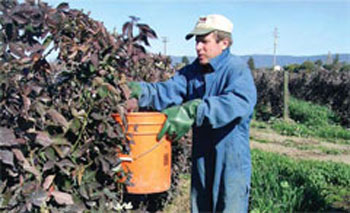All Issues
Plans to control light brown apple moth stir controversy
Publication Information
California Agriculture 62(2):55-56.
Published April 01, 2008
PDF | Citation | Permissions
Full text
The light brown apple moth, an exotic invader that feeds on hundreds of native plants and agricultural crops, continues to gain a foothold in California, but controversy swirls over how to control it.
State plans call for aerial applications of pheromones over parts of nine quarantined counties: Alameda, Contra Costa, Marin, Monterey, San Francisco, San Mateo, Santa Clara, Santa Cruz and Solano. The applications could start as early as June in a few areas, says Kevin Hoffman, primary state entomologist with the California Department of Food and Agriculture (CDFA) in Sacramento. (CDFA also applied aerial pheromones in Santa Cruz and Monterey counties in fall 2007.)
First detected on Feb. 27, 2007, in Berkeley (Alameda County), the light brown apple moth (Epiphyas postvittana) may have arrived in California via nursery stock from its native Australia, scientists speculate. A statewide survey conducted in 2005 found no signs of the leafroller moth, says Curtis Takahashi, biologist with CDFA's Pest Detection/Emergency Projects in San Jose.
According to CDFA, the light brown apple moth threatens the state's multibillion-dollar agricultural industry by potentially destroying, stunting or deforming young seedlings; spoiling the appearance of ornamental plants; and injuring citrus, grapes and deciduous fruit tree crops (also, see page 57).
However, of greater concern to growers is the threat of export restrictions imposed on California crops by trading partners. Already, Mexico and Canada have restricted imports of crops and plants from infested areas; China has taken steps toward such restrictions. Others — including Chile, Korea, Peru and South Africa — list the moth as a quarantine pest and might require certification that a California export is pest-free.
“Trade restrictions would cause the greatest hardship on the fruit, vegetable and nursery industries that export to foreign countries or sell to other states,” notes Lucia Varela, UC integrated pest management advisor. “When the first light brown apple moth was found, Florida immediately threatened to impose restrictions on shipments of those commodities from California. Other states were getting ready to do the same when the USDA stepped in with the order imposing quarantine in areas where infestation has occurred.”
Mark Bolda, farm advisor for strawberries and cane berries in Santa Cruz, Monterey and San Benito counties, demonstrates one method of sampling for leafroller pests in blackberry. This method would be useful for sampling for the light brown apple moth.
Pheromone applications planned
Pheromones are chemical signals shared by members of a species; the light brown apple moth sex pheromone is a perfumelike substance used by the female to attract the male. Wide application of this pheromone confuses males and disrupts the moth's mating cycle, reducing its populations. CDFA officials hope that an early and aggressive program of aerial applications will lead to the moth's eradication.
The synthetic pheromone being applied, called CheckMate, “doesn't kill the moth,” Takahashi says. “But since it's a control agent, it's called a pesticide.”
“Tests are ongoing in New Zealand to determine the best kind of (pheromone) spray to use,” Hoffman says.
Last fall, there were hundreds of health-related complaints from residents after CDFA sprayed pheromones aerially in parts of Monterey and Santa Cruz counties. Takahashi told the February meeting of the Northern California Entomology Society (NCES) that he has responded to complaints related to respiratory problems, burning eyes and burning throats. Some residents expressed concern that the pheromone would kill honeybees. “It won't kill the honeybees and it won't kill the light brown apple moth, either,” Takahashi said. “It's a pheromone.”
A handful of bills have been introduced in the state legislature to stop aerial applications over urban areas, and thousands of Bay Area residents have signed petitions. Four Bay Area city councils have passed resolutions against the aerial applications.
“A large part of the concern is that people don't like to be sprayed by anything,” Hoffman says. “It's a loss of control. It's something they can't see and the general perception is that anything sprayed is toxic, which it isn't.”
Eradication prospects unclear
The light brown apple moth “is not going to be easy to get rid of,” Takahashi says. For one, “it has no true dormancy period in California.”
Hoffman agrees. “It can survive in so many microclimates, and it has a broad host range — it feeds on more than 2,000 different types of native and ornamental trees and can attack more than 250 agricultural crops — and it's fairly widespread.”
For more information:
CDFA
www.cdfa.ca.gov/phpps/PDEP/lbam/lbam_main.html
UC Statewide Integrated Pest Management Program brochure
Light brown apple moth finds in Northern California through Dec. 5, 2007. Source: USDA APHIS 2007, from CDFA data.
As of February 2008, some 17,000 moths had been detected in 14 California counties. The latest was a single moth found in Sonoma County. In addition, single moths were recently reported in Santa Barbara, San Luis Obispo, Los Angeles and Napa counties.
“It can be anywhere — in the grass, clover and trees,” Hoffman says.
The U.S. Department of Agriculture has earmarked about $74.5 million for California to combat light brown apple moth in 2008, including eradication, research, monitoring and regulation.
UC Davis entomologist Frank Zalom says the state appears to be taking a “cautious approach in terms of the safety of [control] technologies both to humans and the environment. Two issues come to my mind — what is the potential impact of doing nothing, and is eradication possible with the available tools given the extent of the infestation?”
Zalom, an expert in integrated pest management, says a critical question concerns the economic impacts of doing nothing to control light brown apple moth. “What is the probability that extensive quarantines would be imposed by trading partners? What would be the resulting cost? Could containment instead of eradication be an acceptable approach?
“It seems that the state should assess whether it pays to try to eradicate, given the present tools, versus containing the pest.”






